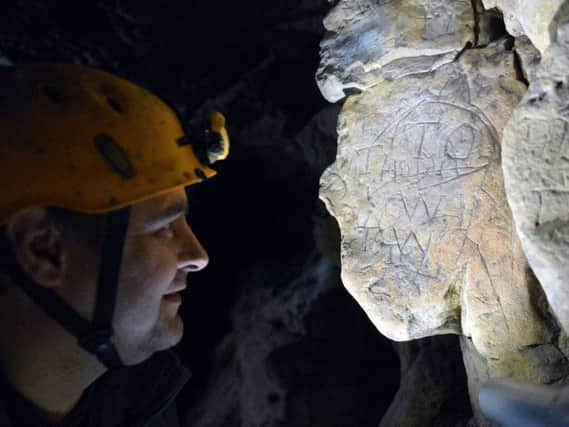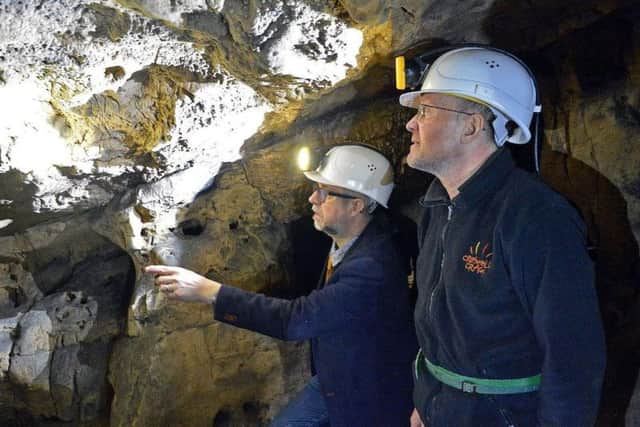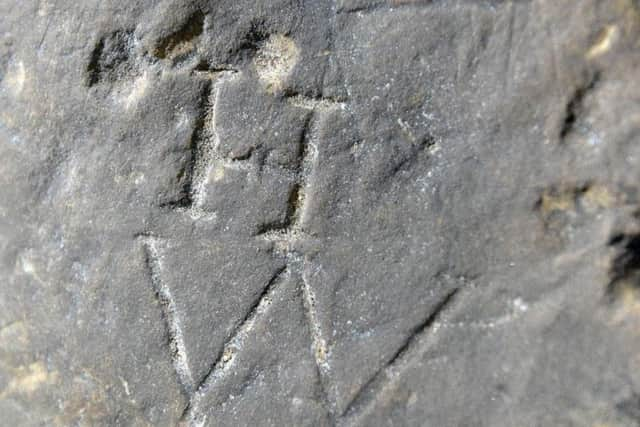Hidden 'witch marks' revealed at Creswell Crags thanks to 3D scanning technology


The marks, discovered earlier this year, are hidden from public view in an inaccessible chamber of a cave at the limestone gorge on the Nottinghamshire/Derbyshire border, with history dating back 60,000 years. Now, new technology will allow Creswell Crags to share the mysterious space with visitors.
Th Apotropaic marks, from the Greek apotrepein, meaning 'to turn away', were scribed into walls and ceilings of the caves, over dark holes and large crevices.
Advertisement
Hide AdAdvertisement
Hide AdThe Creswell Crags discovery is believed to be the largest collection of apotropaic marks in the UK. But the largest concentration is in a chamber which is unsafe for visitors to enter.


Now, 3D scanning and animation technology has opened up a new way to see the Witch Marks.
Jeremy Lee, artist, researcher and principal lecturer from Sheffield Hallam University is working with the team at Creswell Crags to develop an exact digital replica of the cave, and marks.
The hidden cavern is covered with scratches and marks, but the technology captures them accurately.
Advertisement
Hide AdAdvertisement
Hide AdLee is using high accuracy LIDAR scanning, more commonly used to document crime scenes and in surveying, and photogrammetry, which is also used in film and gaming, to build 3D models.


Visitors will be able to explore every corner of the cave and examine every mark, as 'never before'.
Researchers will also be able to gain better, safer access to the marks to aid in finally unlocking the secrets of the cave.
RELATED: PORTAL TO HELL- HUNDREDS OF HISTORICAL 'WITCH MARKS' DISCOVERED IN DERBYSHIRE CAVE IN 'SIGNIFICANT' HISTORICAL DISCOVERYPaul Baker, director of Creswell Crags said: “We may never know what the makers of these marks were seeking protection from or the fear they experienced but the marks are extremely numerous and the concentration in this chamber suggests that this was a significant place.”
Advertisement
Hide AdAdvertisement
Hide AdJeremey Lee, of Sheffield Hallam University said: “I work with new and emerging digital technologies to enable new ways of seeing, creating and experiencing art works.
"The Witch Mark cave has given me an excellent opportunity to utilise these technologies to create this interactive 3D copy of the cave.
"This will render the caves accessible to a broad and distanced audience, whilst enabling a detailed viewing and analysis of the marks inside.”
Ritualistic protection marks are most commonly found in historic churches and houses, near the entrance points, particularly doorways, windows and fireplaces to protect the inhabitants from evil spirits.
Advertisement
Hide AdAdvertisement
Hide AdIt was thought that the largest quantity of witch marks in British caves existed in Somerset, at 57 marks, but the number at Creswell Crags far exceeds that, numbering in the high hundreds in one cave alone. Marks have since been found in all caves at Creswell Crags.
The number and variety of witch mark designs is unprecedented.
Among the most common found are the double VV engravings which are believed to make reference to Mary, Virgin of Virgins and similarly PM is Pace Maria.
Others are believed to be devices for capturing or trapping ‘evil’ and these include diagonal lines, boxes and mazes. The marks appear to have been added to over time and may indicate a need to strengthen the protection in response to a period of unexpected sickness, death or poor crops.
Advertisement
Hide AdAdvertisement
Hide AdThe caves were excavated by archaeologists during the 19th Century and in the process, widened. This may account for why some surfaces feature no marks and might suggest that there were originally an even greater number.
Academic and TV presenter, Professor Ronald Hutton, an authority on folklore, said: “Creswell Crags has already amazed the twenty-first century with its revelations of Palaeolithic designs.
"Now it does so again with a fresh one of medieval and early modern ritual protection marks on a huge scale, making a very important contribution, at a stroke, to one of the most significant current areas of new scholarly research."